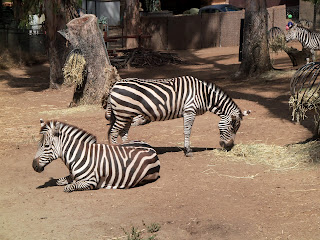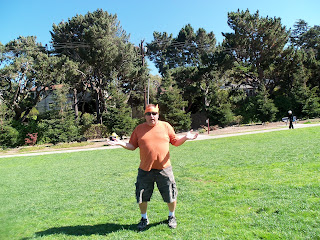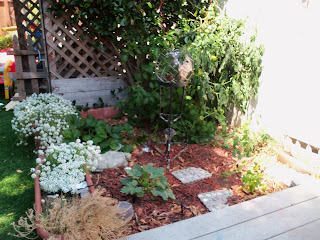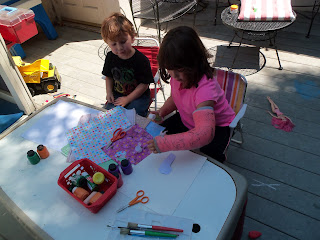A Nomad Way of Life
In Mongolia there are two kinds of people - city dwellers and nomads. Even the capital city used to be nomadic- moving wherever the leaders moved. The nomads make up about half the population of the country. They live with, and for, their livestock, moving across the vast country looking for greener pastures or sheltered areas to spend the cold winter months. There are 5 types of animals raised, called the 5 muzzles, they are:
- Horses- raised for riding and racing, used as wealth and status, and also used to make a favorite beverage "airag", or fermented mare's milk
- Cows and yaks - used for meat and milk
- sheep- used for meat and wool
- Goats- regular goats used for meat and cashmere goats produce one of Mongolia's main exports - fine quality cashmere
- Camels - the two-humped Bactrian camel is used for transport across the Gobi desert because of their ability to handle the extreme temperatures of the area.
The Mongolian nomads typically move 2-3 times a year and therefore need a home that can move with them. Winnebagos are the answer :) No, although they would probably love one, they live in large tents called "gers". If you are familiar with a yurt they are just like that, but apparently the term yurt reminds the people of the invaders from the "west" (where the word yurt originated). So don't call it a yurt. The gers are made with a wooden frame and a felt covering- the whole thing can usually be put up or taken down in about 2 hours. They stay warm in the winter and cool in the summer and are able to resist the strong winds that are common. Similar in concept to both the Zulu huts and the Native American tipi, the elderly get the warmest area away from the door and the stove (or fire) is in the center. It is there, in the center of the home, that the women prepare the meals. Aaah, the food, that brings me to our next project....
Mongolian Food ?!
Ok, so when my daughter picked Mongolia I was excited for the food. I pictured going to the Mongolian Barbeque place or ordering Mongolian Beef from the Chinese food place....well, No and No. Apparently these things are about as Mongolian as I am. Real Mongolian barbeque is cooking a young goat or a marmot (!) by placing hot stones inside the stomach cavity to cook the inside while a torch is used to burn the fur off and cook the outside, this is called Boodog. Or you can have Khorkhog where the meat is cut up and put with some vegetables into a pot with hot stones - sounds a little better but I still understand why there are no real Mongolian restaurants. That and their favorite beverage is fermented horse milk. Definitely one of those things you need to grow up with to enjoy. My picky American kids (and me) aren't quite that adventurous so I went a different way. There any many different variations on the filled pocket in Mongolian food. They can be boiled (bansh), fried (khuushuur), or steamed (buuz). These recipes are all basically the same. Only the cooking method changes - makes deciding what to have for dinner pretty easy, huh?
Buuz - meat-filled steamed dumpling
For the recipe you will need:
Beef, minced - I chopped up a steak in the food processot
onion - again in the food processor (almost pureed) and I used 1/2 since my husband doesn't really like onions :)
garlic - 2 or 3 cloves minced
salt and pepper
a couple mushrooms (not in recipe but they sounded good)
flour
warm water
1. Dissolve a pinch of salt in about 1 1/2 cups of warm water,
2. Add enough flour to form a dough. It was sticky and messy and probably about 3 cups? I didn't measure and recipe was vague.
3. Knead dough and let rest about 30 mins. Then knead it again and make little balls. Sprinkle with flour so they don't stick (mine did anyway) while you make filling
4. Chop everything up in a food processor or with a knife (I'm sure the nomads use the knife) and combine. Filling done
5. Roll each dough ball out (use lots of flour) into a circle and place a spoonful of filling in center. My daughter was pretty good at this
6. Take a side of the dough and bring to center then repeat on all sides until the filling is covered. Or don't, we made them all different. The recipe said each family has their own signature folding technique - ours looked like this...
7. Now steam them for about 20 minutes. If you have a vegetable steamer or one of those cool bamboo steamers that's great. I don't have either so I poked holes in an aluminum pie plate (be careful - I sliced my finger pretty good) and put the pie plate on some wads of foil in a few inches of water. It worked pretty well :)
They were ok, not great. The adults ate them, my daughter ate the dough off of hers, my son completely ignored them. They were fun to make and I think with a different filling they would be a little better. I think they would've been really good deep-fried but then, isn't everything?
















































